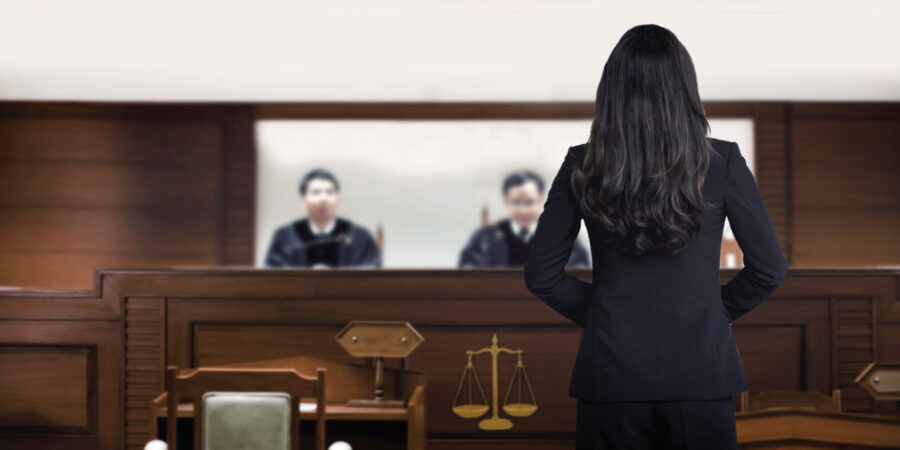What To Expect When You Go To Trial
In some personal injury cases, a person accepts a settlement offer instead of going to trial. Ultimately, the injured person is the one who decides about taking a settlement or proceeding to trial. People often accept settlements when the offer amount is fair. When a client does not feel that the offer is fair and hopes for a better outcome at trial, the attorney files a lawsuit. Many people wonder what to expect when they choose a trial for their California personal injury claim.
It helps to know what happens before and during the trial. The judge determines how long each phase of the lawsuit can take, which may be months or years. The type of case and the details surrounding it determine how long it will take, and some cases are more complex than others. These are the steps that lead up to a personal injury trial.
Complaint and Answer
The person filing the personal injury lawsuit is the plaintiff, and the party that allegedly caused the injury is the defendant. In this step, the plaintiff’s attorney files a complaint in the court with jurisdiction where the injury occurred. Complaint documents provide information about the allegations and resulting damages. The document is then served to the defendant, and the defendant must answer by admitting or denying the allegations within the allowed time. The allowed time in trial is typically 30 days.
Discovery in Trial
This step involves an exchange of information between the plaintiff’s attorney and the defendant’s lawyer. The parties share their documents, evidence, testimonies and other information. Written interrogations and verbal depositions take place during this step for any experts, witnesses or other involved individuals.
Motions in Trial
The defendant may file a motion to dismiss some of the allegations or the entire case. If this happens, the plaintiff’s attorney must file a response quickly to oppose it. There may be a hearing for a judge to hear both parties’ arguments. Motions can be filed during discovery or after it is finished.
Mediation
Some cases are settled by mediation instead of trial. After the previous steps, this may be agreed upon by both parties involved. If the defendant and the plaintiff agree to mediation, a neutral party hears arguments and reads information from both sides. The mediator facilitates negotiations between the two parties and their legal representatives to reach an agreeable settlement. When a settlement cannot be reached, the case then goes to trial. In some cases, a trial may be the ideal choice for a person with a California personal injury claim.
When a case goes to trial, the attorneys for both parties present their arguments to a jury or judge. The judge or jury must determine if the plaintiff is liable and to what extent. This decision also affects the amount of damages in terms of a financial award that the defendant receives. These next steps happen during the personal injury trial.
Conference
Before a trial starts, the judge may meet with both parties’ legal representatives. The judge will ask if there are any changes or new developments to be aware of. If there are no issues, the trial can proceed. The judge uses the information gathered during this meeting to question jurors and present the case in court. Also, details about jury questioning, opening statements and other issues that attorneys handle are discussed during this meeting.
Potential Juror Questioning
Attorneys for both parties can eliminate a few potential jurors for non-discriminatory reasons that they feel go against the best interest of their clients. During this step, potential jurors come into the courtroom and sit in assigned or numbered seats, which the attorneys each have corresponding lists for. The judge presents the basic details of the case for the potential jurors to hear. Next, the judge can ask the individuals questions.
The attorneys present themselves, their clients and the witnesses they plan to call. If any of the potential jurors have a conflict of interest or know any of the named parties, they must make it known. Jurors who work in a field related to the type of personal injury the case is about and do not have a conflict of interest may be valuable for the case. A California injury attorney will likely recommend such a person to be included in the jury. However, those who display biases or other unfavorable behaviors may be dismissed.
Opening Statements
After jury selection and a short break, the trial officially starts. The jurors enter the courtroom. Once they are seated, the attorneys deliver their opening statements. Their statements include what they expect to see happen after the evidence is presented. Although opening statements often last between 30 to 40 minutes, others for more complex cases are longer. Attorneys try to make their opening statements as clear, concise and information-packed as possible to keep the attention of jurors and compel them to see the case from a specific perspective. They may use projectors, computers and other technology to provide visual aids, exhibits or displays.
Testimonies
Once the opening statements have been delivered, the plaintiff’s witnesses testify. Witnesses who were there when the event that led to the injury or had a relevant tie to it are used to support details from the opening statement. Expert witnesses are used to give their interpretation of the facts and support determinations for resulting damages. The plaintiff’s attorney will first question them. Also, the plaintiff’s attorney will attempt to enter exhibits into evidence during this time.
The defendant’s attorney can cross-examine the plaintiff’s witnesses after the plaintiff’s attorney finishes. As the plaintiff’s attorney presents exhibits to become evidence, the defendant’s attorney tries to object to keep out some items. They often try to do this by challenging relevance or authenticity. The defendant’s witnesses testify after the plaintiff’s witnesses finish. Exhibits to challenge the plaintiff’s claims are shown in an attempt to build a defense. Once the defendant’s testimonies are finished, the plaintiff’s attorney may call witnesses to challenge exhibits, evidence or claims made during testimonies for the defendant’s side.
Jury Instructions
A judge considers information from attorneys and witnesses. During this step, there is a lot of consideration about relevance or admissibility of exhibits that were entered as evidence. Additional facts or new information that was presented before the trial may be considered. Attorneys for both parties may argue about what the judge suggests for instructions. During the jury instructions step, the judge usually spends less than an hour reading laws to jurors and develops questions to ask them that will help determine the verdict.
Closing Arguments
Once all the evidence has been received and entered, the final verdict form is developed. The attorneys for both parties deliver closing arguments, which include their interpretation of the evidence and how applicable laws relate to it in favor of their clients. That information is considered and used for jury instructions. Final jury instructions are read by the judge to give the jury a clear understanding of applicable laws and the case’s details.
Jury Deliberation and Verdict
After the closing arguments and jury instructions are finished, the jurors are led to a guarded room where they deliberate. They can ask the bailiff to relay questions or requests for testimonies, evidence or other information. The attorneys and judge review these requests and determine an appropriate response. When the jury reaches a decision, it is sent to the judge for review. The judge can request additional deliberation if there are problems or inconsistencies. A verdict must be agreed upon by at least 10 of the 12 jurors. Once an acceptable verdict is reached, it is delivered and read in court in front of both parties. The losing party has 20 days to request a change in verdict or a new personal injury trial. However, this is rarely granted.
Contact a California Injury Attorney
If you suffered a personal injury because of another party’s negligence, you need a California injury attorney who understands applicable laws and the defenses that work if your case goes to trial. Although people settle many cases out of court, we spare no expense to build the strongest defense for you if your case goes to trial. Your California injury attorney and our team keep you informed every step of the way, and we are here to answer any additional questions you may have. We handle all the complex legal work to help alleviate some of your stress and give you more time to focus on your wellbeing. Please contact us for a free consultation to learn more about filing a California personal injury claim.


